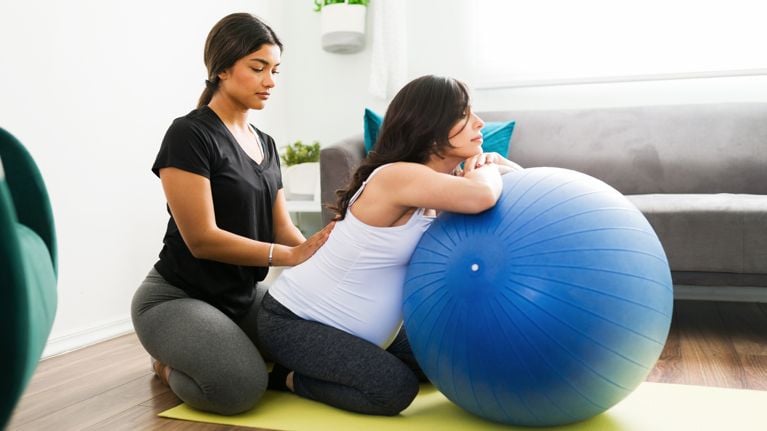There’s no need to take Tlabor lying down, and in fact, lying flat on your back is probably the least efficient way to birth your baby: first because you’re not enlisting gravity’s help to get your baby out, and second because there’s the risk of compressing major blood vessels (and possibly interfering with blood flow to the fetus) when you’re on your back. Expectant mothers are encouraged to labor in any other position that feels comfortable, and to change their position as often as they can (and want to). Getting a move on during labor, as well as varying your position often, not only eases discomfort but may also yield speedier results.
You can choose from any of the following labor and delivery postures (or variations of these):
Standing or walking.
Getting vertical not only helps relieve the pain of contractions but also takes advantage of gravity, which may allow your pelvis to open and your baby to move down into your birth canal. While it’s unlikely you’ll be heading for the track once contractions are coming fast and furious, walking (or just leaning against a wall or your coach) during the early stages of labor can be an effective move.
Rocking.
Sure, your baby’s not even born yet, but he or she will still enjoy a little Remember that the best labor position is the one that’s best for you. rocking-as will you, especially when those contractions start coming. Slip into a chair or remain upright, and sway back and forth. The rocking motion may allow your pelvis to move and encourage the baby to descend. And again, staying upright allows you to use the force of gravity to help in the process.
Squatting.
You probably won’t be able to stand and deliver, but once you get closer to the pushing phase of childbirth, you might want to consider squatting. There’s a reason why women have delivered their babies in a squatting position for centuries: It works. Squatting allows the pelvis to open wide, giving your baby more room to move on down. You can use your partner for squatting support (you’ll
probably be a little wobbly,
so you’ll need all the support you can get), or you can use a squatting bar, which is often attached to the birthing bed (leaning on the bar will keep your legs from tiring out as you squat).
Sitting
Whether in bed (the back of the birthing bed can be raised so you’re almost sitting upright), in your partner’s arms, or on a birthing ball, sitting can ease the pain of contractions and may allow gravity to help bring your baby down into the birth canal. You might also consider a birthing chair, if one is available, which is specifically designed to support a woman in a sittingor squatting position during delivery and, theoretically, speed labor. Another plus Moms get to see more of the birth in this position.
Kneeling.
Got back labor? Kneeling over a chair or over your spouse’s shoulders is a great position when the back of the baby’s head is pushing against your spine. It encourages the baby to move forward, taking that load off your back. Even if you don’t have back labor, kneeling can be an effective labor and delivery position. Because kneeling allows you to shift and transfer some of the pressure toward the lower spine while you push your baby out, it seems to reduce childbirth pain even more than sitting does.
Hands and knees.
Getting on all fours is another way to cope more comfortably with back labor-and to help get that puppy out faster. This positionallows you to do pelvic tiltsfor comfort,while giving your spouse or doula access to your back for massage and counter pressure. You might even consider delivering in this position (no matter what kind of labor you’re having), since it opens up the pelvis and uses gravity to coax baby down.
Side lying.
Too tired to sit? Or squat? Just need to lie down? Lying on your side is much better than lying on yourback, since it doesn’t compress the major veins in your body. It’s also a good delivery option, helping to slow a too-fast birth as well as easing the pain of some contractions.Remember that the best labor position is the one that’s best for you. And what’s best in the early stages of labor might make you miserable when you’re in the throes of transition, so change positions as often-or as little- as you want. If you’re being continuously monitored, your positions are somewhat limited. It’ll be hard to walk, for instance-but you’ll have no problem squatting, rocking, sitting, getting on your hands and knees, or lying on your side. Even if you have an epidural, sitting, side lying, or rocking are options available to you.
Extract from
“What to Expect When you’re expecting”
By Heidi Murkoff and Sharon Mazel



